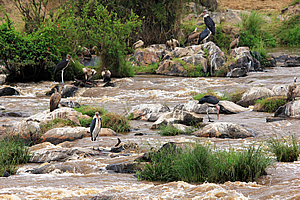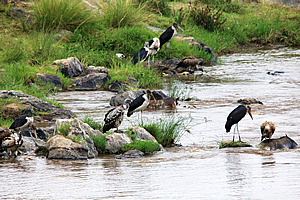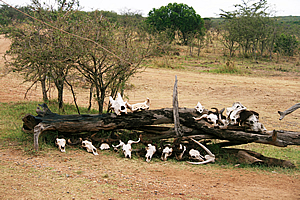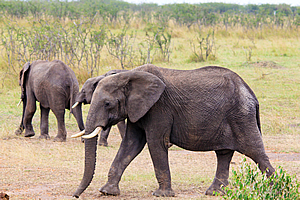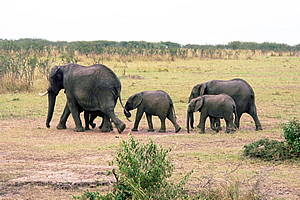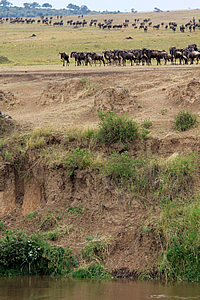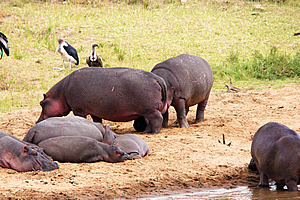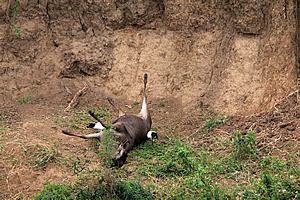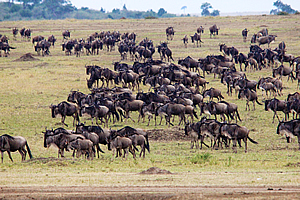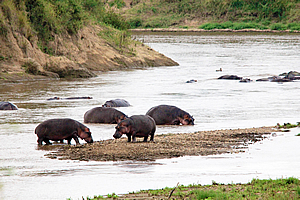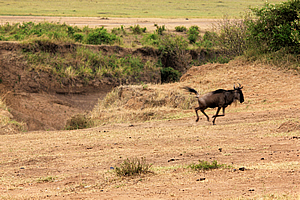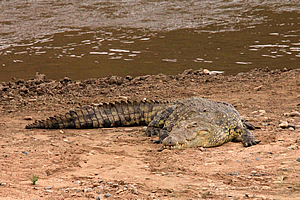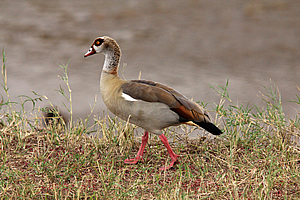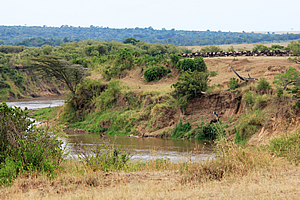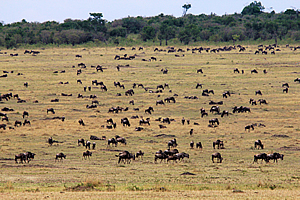--- Archive files ---
Home > Travels > Masai Mara > 11 |
The Mara River
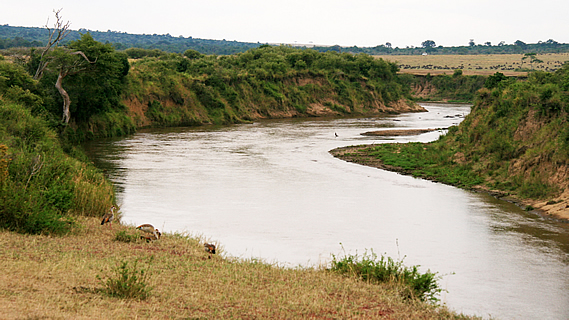
I COULD smell the foul stench even before I could see it. The van slowed down as we started a short descent approaching the bridge over the Mara River. We carefully crossed the rickety bridge. I looked down at the fetid brown river tumbling over what I initially thought were rocks with storks and vultures standing on them. Then I realised these rocks were actually the dead bodies of wildebeest, almost perfectly blending in with the real boulders that lined the sides of the river and protruded above the cascades. There were many carcasses scattered along the swollen river with the birds eating their rotting flesh. The stench was unbelievable.
Feeding on carcasses in the Mara River |
I had seen this famous river in many a documentary, but none had mentioned the foul stench.
The river was brown and obviously running higher than usual due to the overnight rain. The bridge spanned about four metres above the river, with a ford below us. I’m sure the van would not have been able to make it across the ford, but it was there for very large vehicles that exceeded the weight limits of the bridge.
Feeding on carcasses in the Mara River |
There was a short queue of vehicles so we were fortunate in stopping in the middle of the bridge. This allowed me the opportunity to photograph the river before the queue cleared allowing us to cross over to a small hut where Joseph signed us into what was apparently another area of the park. There was a big sign outside the hut which read:
Wild animals can be extremely dangerous. Only leave your vehicle at designated points, after ensuring there is no danger. The Mara conservatory accepts no responsibility for any injury or death caused by wild animals.
Skulls near the Mara River bridge |
The sign was a plaque set into a stone wall put together by mortar. On top of the stone wall were two skulls. The bottom one was a wildebeest and the top one a gazelle. The two skulls fitted onto each other very well almost merging into one. Each skull had a set of horns that gave the impression the skull had four horns. Nearby were a couple of old logs washed down by the river and collected and stacked horizontally on top of each other. A row of skulls lined the top log, and another row lined the ground immediately in front of the dead branches. They seemed to mostly be wildebeest with their curled horns, a few gazelles with their much straighter horns pointing upwards, and a huge elephant skull.
Elephants |
Once we were signed in, we continued along the road following the bank high above the river, crossing another bridge over a much smaller stream shortly afterwards.
Shortly after leaving the hut over the bridge, we saw an entire family of grey elephants crossing the road a short distance ahead of us. There were several adults – three huge males, three smaller females and three calves, nine in total. Perhaps this was an extended family with so many calves. Although nothing dares to take on an adult elephant, the calves are still at risk from the more ambitious predators. In the distance behind the elephants was some scrub with the long necks of several giraffe poking up out of it.
Elephants |
The family quietly plodded across the road and ambled off together into the scrub before we continued along the main trail.
Another five minutes passed before we returned to the river. Here the banks on either side were about twelve metres high leaving a fairly narrow gorge through which the river meandered a little higher than usual following last night’s heavy rain. The river cut deeply into the banks on either side showing recent erosion of where parts of the bank had collapsed with small islands of grass still growing on them. There were stony spits along the side of the river where grass grew. The river obviously hasn’t been high for a long time. Tourist vehicles were strategically parked on either side of the river.
Wildebeest contemplating the crossing |
There was very little wildlife on this side of the river apart from one small herd of wildebeest which had made the crossing earlier today but looked ready to move on. They were in amongst long grass and numerous huge termite mounds. Near the river where all the vehicles the grass was very short, but I this was mainly to do with the traffic rather than the grazing. There were a lot of tyre tracks here from all the vehicles that had been through here. I imagined during prolonged rain this area would get very muddy.
At the entrance to a large parking area was a large sign:
Mara River. Lake Victoria South Catchment Area. Drainage Basin Area 8967 sq km. Total river length 270km.
This was one of the many sources of the Nile. On the other side of the river were many thousands of wildebeest and zebra.
Hippos |
In the river itself were a number of hippopotami standing on the stony spit around one of the meanders. There was another spit below us, here I saw two almost perfectly camouflaged Nile crocodile sitting there awaiting a feast. There were numerous birds standing on the same stony spit.
There were a few carcases in the river, and one lying splayed on its back where it had taken a tumble half way down the other side. Although there were carcases in the water here, this area didn’t have the same degree of stench as at the bridge. Perhaps this was because the recently killed animals are quickly washed downstream to catch on the rocks of the cascade just upstream from the bridge.
Wildebeest that didn't make it |
Downstream the gorge ended and the river banks were fairly flat. The terrain was rough and scrubby showing as remnants of where steep banks had once stood as they do now in this section of the river. It was very difficult to get through, so that was why the wildebeest crossed here.
A few small brightly coloured ducks walked along the edge of the cliff near where we were parked. They were brown coloured but had a lot of interesting texture.
There was quite a substantial group of wildebeest standing at the edge of the cliff on the other side anticipating the crossing. They have an annual migration going around from Masai Mara down to the Serengeti in Tanzania. Three million of them rotated around the huge loop. They eat the grass until it wears too thin so they continue their circle. Their droppings provide the fertiliser for it to grow again in time for next year’s migration. Most of the way around the circle is obstacle clear, except for here.
Wildebeest grazing on very short grass before the crossing |
The edge of the bank was bare dusty soil, from where the millions of wildebeest and zebra procrastinate before their crossing. In their nervousness they would eat any grass near the bank and would churn the rest of it into dust – although after last night’s unseasonal rain the dust would have turned to mud like it had done on the Ilariak Road this morning.
This is the one major river crossing the migrating wildebeest and zebra have to do every year. They normally reach the Mara River at this time of the year in August when the river is at its lowest, and then they swim across. The rain last night had raised the river to a higher than normal level for this time of the year, so most were reluctant to cross.
Hippos |
The crossing involves going down the very steep bank, swimming across the river, and then climbing up the other side. Then they have to find a large group. The grass on the other side of the river was well eaten with the huge concentrations of wildebeest eating it. On this side the grass was very long. Obviously when they reach this side they are keen to quickly move on leaving the grass largely untouched.
Some of the hippopotami in the river crawled out of the water and stood on the middle of a flat dry bank in the middle of the river.
There was another brown bird pecking its way in the grass near our van. A white bird soared along the length of the river heading upstream towards the hippopotami. There were now more standing on the stony bank in the middle of the river no doubt warming themselves up.
Sole wildebeest that made the crossing |
A solitary wildebeest suddenly appeared in front of the van, scurrying up the final steps of the steep cliff bank out of the water. There was a gully cut into the ground which it had taken advantage of, although there was a lot of scrub in the gully, it was obviously the most attractive option for the wildebeest. I had missed it entering the water. Perhaps it had gone in further upstream and got carried by the current to this part of the river. Once on the flat terrain at the top of the cliff, it hurriedly scampered of into the long grass hopefully in search of a herd.
Crossing the Mara River alone is very dangerous. This was the situation where safety in numbers really applies, and why most hoofed herbivores have evolved to live in herds. In the presence of so many carnivores, especially their main hunter the lion, leaving the crowd endangers you.
Nile crocodile |
Now these animals usually cross the river in large groups. It is far harder for a crocodile or other predator to attack an animal when it is part of a large herd. That being said though whenever a bunch of animals is standing on the top of the cliff on the other side, each animal is thinking I am not going to go until another animal leads me. These animals are all followers, not leaders. Only when one animal stands up and leads the others do the others actually follow.
I am guessing that the wildebeest that had just crossed the river was one such leader who had plucked up the courage to literally take the plunge with the expectation that others would follow. Unfortunately none of the others followed it, so this wildebeest had to cross the river alone.
Duck on top of the bank |
The other possibility is that the wildebeest had gotten a bit too close to the edge of the cliff on the other side and had fallen down. Fortunately unlike the dead one half way down the cliff on the other side, this one had somehow escaped unscathed and realised the only thing to do was to swim across and head up the other side getting the crossing over and done with.
Either way this wildebeest had taken the plunge when all others wouldn’t go. They were all waiting in herd style for the right opportune moment when perhaps the river drops a little. It reminded me of a lot of people I know who don’t have the self-confidence to stand out on a limb and take the plunge just because they are faced with adversity.
The Mara River |
This was the only wildebeest we saw crossing the river all day. I was amazed that none would take the bridge. It has been there for many years just two kilometres downstream. Surely that would be remembered in their migration routes by now, but apparently not.
We spent another hour watching the wildebeest willing them to make the crossing. There were numerous other vehicles there full of tourists wanting to do the same thing. Some were galloping up and down the top of the cliff as if working themselves up to make the crossing. This was their most challenging part of the migration. No doubt the younger ones were all doing it for the first time.
A group of hippos I had not seen earlier came out of the water and laid their very fat bodies onto their sides on the dusty sand on a ledge beside the river. The adults were all a deep purple colour, but there were a number of small juveniles that were coloured a much softer grey colour.
Wildebeest on the other side |
We drove a bit further up the river to get a better vantage point, but that didn’t help. No more wildebeest crossed over the river. They must have all decided the water level was too high today. We unpacked our lunches from the chilli bin and ate it. We stayed for another half hour, but left without having seen any more wildebeest crossing the legendary Mara River. Joseph mentioned that if none would have crossed by now, then there was no way that any would cross before tomorrow.
He said we had been extremely lucky though to have seen a leopard and a cheetah, and he also said there was a small chance we may see a rhino as well. None of which he had seen in three months.
I still considered this to be a very successful day – I had seen one Wildebeest crossing out of the river. Joseph hadn’t seen it.
<< Previous | Next >> |
|
||
About this Page
|
||
|
|
|
Where is Walkabout Jeff? |
|
|
|
|
What is happening in Walkabout Jeff's hometown?
|
|
|
|
|
Who is Walkabout Jeff?Any normal person's idea of going out involves going to the local pub for a drink with a few mates. Walkabout Jeff isn't normal.
|
|
|
|
|
